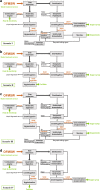Exploring biorefinery alternatives for biowaste valorization: a techno-economic assessment of enzymatic hydrolysis coupled with anaerobic digestion or solid-state fermentation for high-value bioproducts
- PMID: 38265757
- PMCID: PMC10810166
- DOI: 10.1080/21655979.2024.2307668
Exploring biorefinery alternatives for biowaste valorization: a techno-economic assessment of enzymatic hydrolysis coupled with anaerobic digestion or solid-state fermentation for high-value bioproducts
Abstract
Enzymatic hydrolysis of organic waste is gaining relevance as a complementary technology to conventional biological treatments. Moreover, biorefineries are emerging as a sustainable scenario to integrate waste valorization and high-value bioproducts production. However, their application on municipal solid waste is still limited. This study systematically evaluates the techno-economic feasibility of the conversion of the organic fraction of municipal solid waste (OFMSW) into high-value bioproducts through enzymatic hydrolysis. Two key variables are examined: (a) the source of the enzymes: commercial or on-site produced using OFMSW, and (b) the treatment of the solid hydrolyzate fraction: solid-state fermentation (SSF) for the production of biopesticides or anaerobic digestion for the production of energy. As a result, four different biorefinery scenarios are generated and compared in terms of profitability. Results showed that the most profitable scenario was to produce enzymes on-site and valorize the solid fraction via SSF, with an internal rate of return of 13%. This scenario led to higher profit margins (74%) and a reduced payback time (6 years), in contrast with commercial enzymes that led to an unprofitable biorefinery. Also, the simultaneous production of higher-value bioproducts and energy reduced the economic dependence of OFMSW treatment on policy instruments while remaining energetically self-sufficient. The profitability of the biorefinery scenarios evaluated was heavily dependent on the enzyme price and the efficiency of the anaerobic digestion process, highlighting the importance of cost-efficient enzyme production alternatives and high-quality OFMSW. This paper contributes to understanding the potential role of enzymes in future OFMSW biorefineries and offers economical insights on different configurations.
Keywords: Techno-economical assessment; anaerobic digestion; biopesticide; biorefinery; enzymatic hydrolysis; organic fraction of municipal solid waste; sensitivity analysis; solid-state fermentation; valorization.
Plain language summary
Techno-economic analysis to assess enzyme origin and solid hydrolysate fate.The viability of enzymatic hydrolysis depends on the cost and origin of enzymes.On-site produced enzymes cut payback time to 6 years, elevating profits by 74%.Anaerobic digestion and solid-state fermentation can be complementary technologies.High-value bioproducts are key to making organic waste biorefineries profitable.
Conflict of interest statement
No potential conflict of interest was reported by the author(s).
Figures





Similar articles
-
Enzymatic hydrolysis of the organic fraction of municipal solid waste: Optimization and valorization of the solid fraction for Bacillus thuringiensis biopesticide production through solid-state fermentation.Waste Manag. 2022 Jan 1;137:304-311. doi: 10.1016/j.wasman.2021.11.014. Epub 2021 Nov 22. Waste Manag. 2022. PMID: 34823137
-
Filling in the gaps in biowaste biorefineries: The use of the solid residue after enzymatic hydrolysis for the production of biopesticides through solid-state fermentation.Waste Manag. 2023 Apr 15;161:92-103. doi: 10.1016/j.wasman.2023.02.029. Epub 2023 Mar 3. Waste Manag. 2023. PMID: 36871406
-
Production and characterization of β-glucosidase from Aspergillus niger fermentation: Application for organic fraction of municipal solid waste hydrolysis and methane enhancement.Biotechnol Prog. 2020 Jan;36(1):e2902. doi: 10.1002/btpr.2902. Epub 2019 Oct 1. Biotechnol Prog. 2020. PMID: 31469516
-
Thermally enhanced solubilization and anaerobic digestion of organic fraction of municipal solid waste.Chemosphere. 2021 Nov;282:131136. doi: 10.1016/j.chemosphere.2021.131136. Epub 2021 Jun 8. Chemosphere. 2021. PMID: 34470172 Review.
-
Biological nutrients removal from the supernatant originating from the anaerobic digestion of the organic fraction of municipal solid waste.Crit Rev Biotechnol. 2014 Sep;34(3):244-57. doi: 10.3109/07388551.2013.791246. Epub 2013 Jul 1. Crit Rev Biotechnol. 2014. PMID: 23808751 Review.
Cited by
-
Functional and Bioactive Benefits of Selected Microalgal Hydrolysates Assessed In Silico and In Vitro.Mar Drugs. 2025 Jan 22;23(2):53. doi: 10.3390/md23020053. Mar Drugs. 2025. PMID: 39997177 Free PMC article.
References
-
- Budzianowski WM, Postawa K.. Total chain integration of sustainable biorefinery systems. Appl Energy. 2016;184:1432–18. doi: 10.1016/j.apenergy.2016.06.050 - DOI
-
- Moreno AD, Magdalena JA, Oliva JM, et al. Sequential bioethanol and methane production from municipal solid waste: an integrated biorefinery strategy towards cost-effectiveness, process saf. Environ Prot. 2021;146:424–431. doi: 10.1016/j.psep.2020.09.022 - DOI
-
- Molina-Peñate E, Artola A, Sánchez A.. Organic municipal waste as feedstock for biorefineries: bioconversion technologies integration and challenges. Rev Environ Sci Bio/Technol. 2022;211(21):247–267. doi: 10.1007/S11157-021-09605-W - DOI
Publication types
MeSH terms
Substances
LinkOut - more resources
Full Text Sources
Other Literature Sources
Research Materials
